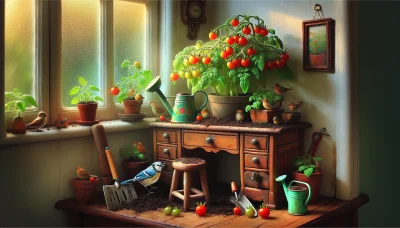Exploring Faux Bois Art Quiz
Test Your Knowledge
Question of
Exploring Faux Bois Art in Gardening
Faux Bois, translating to "false wood" in French, is an artistic tradition that dates back to the Renaissance period, where artisans meticulously crafted wood-like structures from concrete, iron, and other materials. This unique form of artistry gained prominence in garden design, especially during the 19th and early 20th centuries, as a means to blend man-made features seamlessly with the natural landscape. Faux Bois art in gardening is celebrated for its ability to create whimsical, durable garden structures such as benches, trellises, and bridges that mimic the intricate textures and forms of trees and branches. Its historical significance lies in its blend of functionality and aesthetics, offering a timeless appeal to gardens and outdoor spaces.
The Techniques Behind Faux Bois
Faux Bois, French for "false wood," is an artistic technique developed to imitate the appearance of wood through various materials and processes. Traditionally, craftsmen would use a combination of concrete, plaster, and paint to create structures and objects that mimic the texture, color, and grain of real wood. The process begins with the construction of a framework, often made of metal wires or mesh, shaped into the desired form. This framework is then coated with a layer of concrete or mortar, sculpted while still wet to resemble wood grain and textures. After drying, additional details can be carved into the surface before it is painted and stained to achieve the natural hues and variations found in wood. This meticulous art form requires a deep understanding of both the materials involved and the characteristics of different wood types, allowing artists to create realistic and durable replicas that can withstand the elements when used in outdoor settings.
Faux Bois Today: A Modern Twist
Contemporary artists and garden designers are breathing new life into the traditional craft of Faux Bois, or "fake wood," by integrating it into modern gardening and landscape design in innovative ways. Once primarily focused on creating concrete structures that mimic the intricate patterns and textures of wood, today's practitioners are pushing the boundaries of the medium. They are blending Faux Bois with modern materials and techniques, creating pieces that are at once whimsical and sophisticated, seamlessly merging the rustic charm of wood with the clean lines and durability of contemporary design elements. This fresh take on Faux Bois is helping to redefine outdoor spaces, offering a unique blend of artistry and functionality that enhances the natural beauty of gardens and landscapes while paying homage to the craft's rich history.
Creating Your Own Faux Bois Pieces
- Start with Inspiration: Look at images of real wood and Faux Bois pieces to inspire your designs.
- Choose the Right Materials: Use concrete or a sculpting compound suitable for outdoor use.
- Get Familiar with Tools: Familiarize yourself with wire brushes, grout tools, and wood grain stamps.
- Practice Your Technique: Practice creating wood grain patterns on a small scale before starting your project.
- Create a Skeleton: Build a wire or rebar frame as a base for your sculpture.
- Apply Your Medium: Cover your frame with the sculpting compound, then shape and texture it to resemble wood.
- Dry and Cure: Allow your piece to dry slowly, following the material’s guidelines for curing times.
- Add Finishing Touches: Once dry, paint or stain your piece to enhance the wood effect and protect it from the elements.
- Place in Your Garden: Find the perfect spot in your garden for your Faux Bois piece and enjoy!
The Role of Faux Bois in Sustainable Gardening
Faux Bois, or "false wood," is a unique form of art that imitates the appearance of wood through various materials and techniques. In the context of sustainable gardening, Faux Bois offers an innovative approach to incorporating wood-like structures without the need to harvest live trees. This practice aligns with eco-friendly principles by reducing deforestation and promoting the use of sustainable materials. Artists and gardeners can utilize recycled metals, eco-friendly concrete, and other sustainable composites to create intricate designs that mimic natural wood. These creations can range from functional garden furniture to decorative elements, all while preserving natural resources. The integration of Faux Bois into garden design not only enhances aesthetic appeal but also supports environmental conservation efforts, making it a valuable component of sustainable gardening practices.
Faux Bois Art Galleries and Exhibitions
| Name | Location | Description |
|---|---|---|
| Villa Celle Faux Bois Collection | Pistoia, Italy | A prestigious collection within the Villa Celle showcasing exceptional Faux Bois pieces in an expansive Italian garden setting. |
| San Antonio Botanical Garden | San Antonio, Texas, USA | Home to an impressive Faux Bois installation by artist Dionicio Rodriguez, located in the Texas Native Trail section of the garden. |
| Parc de la Tête d'Or | Lyon, France | Features historic Faux Bois structures such as bridges and benches, blending art with the natural beauty of one of France's largest urban parks. |
| The Huntington Library, Art Museum, and Botanical Gardens | San Marino, California, USA | Offers a diverse collection of art and botanical specimens, including a Faux Bois treehouse in the Children's Garden. |
| Tower Grove Park | St. Louis, Missouri, USA | This historic park features unique Faux Bois pavilions, bridges, and benches, showcasing the craftsmanship of the early 20th century. |












